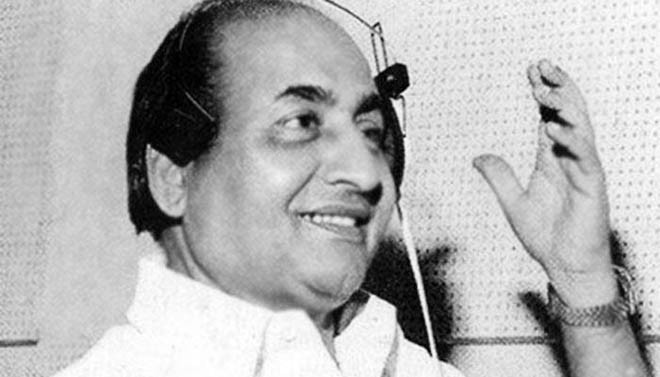
Mohammed Rafi, the most popular male singer in the subcontinent, never tinkered with the essentials of the music tradition

Growing up in the 1950s and 60s, the only music that could be heard without making an effort was that of the films. The medium through which it was heard was the radio as various stations -- Radio Pakistan, Vividh Bharati/All India Radio and slightly later Radio Ceylon broadcasted film songs which could be enjoyed free of cost by a population that was not really aware that listening to music ought to be paid for. Hardly anyone paid the mandatory radio license fee.
It was not that most of the households possessed radio sets. Not very many did -- some due to financial limitations, others for reasons of morality. It was feared that radio being an evil device containing songs was a great danger to youngsters and women. If some households had radio sets, these were only switched on for the news; and perhaps, some religious programmes and switched off -- all under strict parental or grandparental supervision. Outside the house, in the big bad world radio could be heard on the khokhas, small eating joints and bus stops -- mostly blaring away film songs or ball-by-ball commentary on test matches (whenever held) at full volume.
Watching a film was like committing thievery -- an act conducted with one’s friends or a truant relative, totally concealed from the eyes of parents and the elders of the family. For men, if caught watching a film resulted in being branded vagabonds, for women a grave breach of their and the family’s honour that could lead to grave social and physical consequences.
Indian films had been banned in Pakistan in the mid-1950s and the reruns of films already imported were held repeatedly -- this too, was put to an end by a policy of screening no Indian film after the 1965 war. From then to the mid-1970s - till the commissioning of Amritsar Television and then the VCR revolution -- only Indian film music could be heard while no Indian films could be watched. Thus, especially in Pakistan this survived as a song form of music and not as part of an overall film situation.
But, what one heard on the radio were mostly the songs of Lata Mangeshkar and Mohammed Rafi. While Rafi was the most popular male singer in the subcontinent, ruling the world of music from faraway Bombay, one heard rumours that he was from Lahore and had lived in the city before moving on to greener pastures. The information about films, stars and singers was mostly in the form of rumours bordering on the scandalous. The other source, perhaps relatively more reliable or so we thought, were the film magazines that thrived on creating rumours and scandals; these, then, like today, were accepted as gospel truth by a gullible readership.
Most youngsters hummed his songs, either wallowing in their imagined misery or wanting to woo the girl next-door. Most admired him, except a few with chip on their shoulders delving into some arcane analysis in the desire to not be part of the herd. Many found him as a counter to the chore of taking a bath and very many thought they were far better than him, only fate had conspired against them or an opportunity had not come their way. He was popular; he could be fooled around with -- he could be taken liberties with, he could be treated at random and taken for granted.
One got to know later that he was born in village Kotla Sultan Singh in the Punjab and moved to Lahore and spent the formative period of his life in the city working as a barber in a family enterprise round Mohni Road and Bhati Darwaaza. But his heart lay in music and he moved and mixed freely with the music circles picking up the intricacies of music from a number of well-known vocalists and instrumentalists of Lahore. The music scene was quite vibrant and people like Jeevan Lal Mattoo served as connoisseurs and patrons of music in the city. It was in these baithaks and soirees that Mohammed Rafi picked up the finer aspects from Ustads like Abdul Waheed Khan and Chotay Ghulam Ali Khan. Feroz Nizami introduced him to the Radio, in Lahore before he made his film debut for Shayam Sunder’s Punjabi Film, Gul Baloch in 1944. He moved to Bombay and was given a break by Naushad in film Pehle Aap, the same year.
Initially, film music looked for its first real male singer and found one in Kundan Lal Saigal who dominated the next 15 years till his untimely death when barely in his 40s. The field was left wide open and a number of singers rushed in like Mukesh, Talat Mahmood and Mohammed Rafi to fill the void. Mohammed Rafi proved to be the most popular because of his greater versatility.
Since music was making a transition from the purist tradition cultivated by individual patrons and super virtuosity of master musicians to a more popular level, hemmed in by the limitations of the market and disparate popular expectation, the music composers did a fine job of not letting go of the essentials of their local musical traditions. Mohammed Rafi lived in that phase and despite the innovations and changes never tinkered with the essentials of the music tradition. Though he was noticed in Anmol Ghadi and sang alongside K.L Saigal in Shahjehan, both under the music direction of Naushad, it was his duet with Noor Jehan in Jugnu composed by Feroz Nizami that catapulted him as a serious contender to fill the vacant slot of the leading male vocalist. He truly arrived as an individual vocalist in Mela where again he sang under the musical direction of Naushad.
Mohammed Rafi died on July 31, 1980